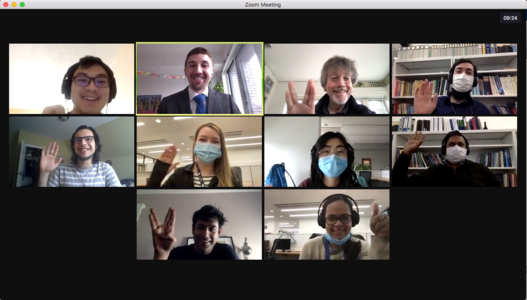
On March 24, 2021 Olivier Trottier successfully defended the thesis: “Morphogenesis of class IV neurons in Drosophila melanogaster” (Advisor: Joe Howard).
Trottier explained, “Neurons are the primary units of the nervous system allowing multicellular organisms to perceive and respond to their environment. The proper development of the neuronal morphology is essential to establish its function within the organism. In my thesis, I investigate the development of the dendritic tree in the class IV neurons of fruit fly larva in order to better understand how neuronal morphologies are established over the development of the cell. We characterize the growth processes and morphology of class IV neurons and propose two models of neuronal growth that reproduce the morphology that we observe. We find that the structure of the dendritic tree emerges from the local growth dynamics of the cell hinting that the cell controls its shape via intracellular molecular mechanisms. In addition, this work establishes a theoretical and computational framework to study neuronal development.”
Currently Trottier is undecided on his future plans.
Thesis Abstract: The establishment of the neuron’s morphology is essential to its function. The class IV neurons of the Drosophila melanogaster larva are two-dimensional sensory neurons that develop a complex dendritic arbor sensitive to mechanical stimuli. The fully-developed dendritic tree results from a multitude of stochastic processes including dendritic tip growth, branching and self-avoidance. However, it is yet unknown how the microscopic dendritic growth processes produce the macroscopic morphology of the class IV neurons. In this study, we aim to bridge this gap by formulating multi-scale models of neuronal dendritic morphogenesis. We begin by analyzing the tip dynamics and branching process of class IV dendritic trees. We find that the tip growth dynamics can be described by a Markov process that transitions between three velocity states: growing, paused and shrinking. Driven by the results of our analysis, we propose two types of model of morphogenesis. First, we use the mean-field approximation to formulate dendritic tree growth as a system of reaction-diffusion equations with two kinds of species, dendrites and tips. This coarse-grained approach predicts that the dendritic tree grows by the propagation of a density wave whose tail stabilizes to a steady-state. Second, we construct an agent-based model of morphogenesis that implements the stochastic rules of microscopic tip growth and branching whose combined effects lead to the development of the dendritic tree. Within the limitations of the model, this more fine-grained approach predicts morphometrics that agree with the measured values. In summary, our results characterize the development of class IV neurons and provide a framework to understand how the large-scale morphology of the class IV neuron dendritic tree emerges from the local stochastic growth of its branches.

